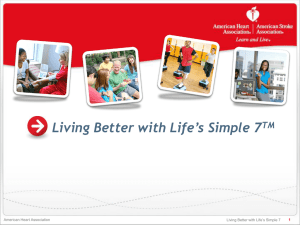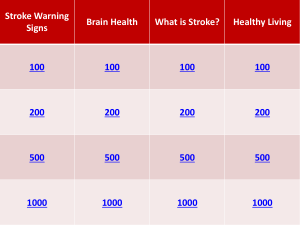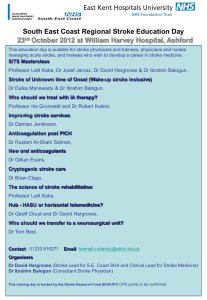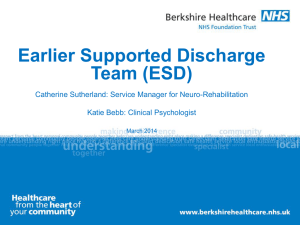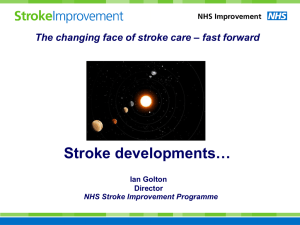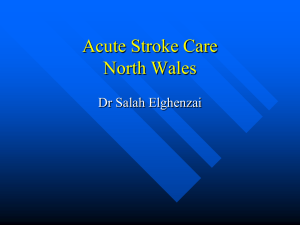STROKE - Garden City Hospital
advertisement
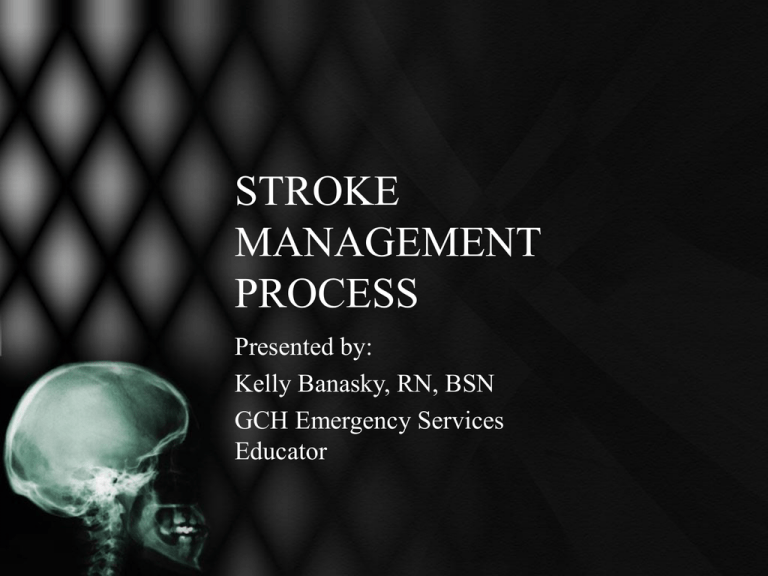
STROKE MANAGEMENT PROCESS Presented by: Kelly Banasky, RN, BSN GCH Emergency Services Educator Why are we doing this? • Garden City Hospital is seeking certification as a designated Stroke Center to better serve our community and patients • To accomplish this, education is necessary to care for stroke patients • Garden City Hospital Emergency and Cardiology Departments have been successful with management of AMI’s • Garden City Hospital would like to have a similar process for AIS (Acute Ischemic Stroke) U.S. Stats • Every 40 seconds, someone will experience a stroke. • 795,000 thousand people suffer a stroke annually within the US • The annual stroke related medical and disability cost is 73.7 billion dollars. • Every 4 minutes someone dies from a stroke. • By the end of this entire 2 ½ hour presentation: • 225 people will have experienced a stroke • At least 37 individuals will have died from a stroke Local Stats • In 2008 there were 125 deaths total from cerebrovascular disease in the following communities: • Dearborn Heights - 31 • Garden City - 16 • Inkster - 7 • Redford Twp. - 29 • Westland – 42 • Garden City Hospital regularly sees patients from these communities • Stroke impacts our surrounding community personally Critical Recognition • Individuals with signs and symptoms of a stroke may not always arrive from the Emergency Department • Sometimes patients wait to go to the ED. • It could be an admitted patient that you are caring for • It could be a visitor anywhere in our facility • It could be someone you know • a family member • A friend • A neighbor • It could be you. Signs & Symptoms & Time • Time is the single most important factor in recognizing and treating a stroke. • Time is Tissue…Time is Brain…Time is function • Knowing the symptoms and ACT FAST can help prevent the further deterioration of a stroke. • Critical information needed: • When was the last time the individual was unaffected/normal • Ask questions of family, friends, staff • Knowing the last time the person was unaffected determines treatment options How do we recognize a stroke? • • • • • • • • • • Unilateral facial droop, arm droop Weakness or numbness to one side of the body Sudden confusion or dizziness Right or Left visual field deficits Dysarthria, dysphagia Sensory loss in all 4 limbs Decreased consciousness Complaint of worst headache in life Light intolerance Nausea/vomiting Continuity of Care Across our Spectrum • The initial interventions in all areas are universal. • The ED and RRT are both expected to follow the algorhythm to maintain consistent care at all times. • While the interventions are the same, there will be some differences • ED utilizes CPOE • Hospital wide utilizes Invision order entry • The same process of actual intervention is to occur no matter where the individual is located. Initial Actions by ED & RRT • The goal is universally consistent care by ED and RRT. • Initial actions that occur in the ED will also be expected to occur throughout the hospital. • Once a stroke is recognized, it is critical that the following occurs • If outside the ED, call the Rapid Response Team • contact the CT scan room in radiology to notify CT staff of “Stroke Protocol” • Contact the Stroke Team • Enter Orders for Stroke Algorhythm • Answer return phone calls from the Stroke Team Points to consider specific to RRT • RRT is to be called for all in-house patients and visitors suspected of having a stroke • Always follow hospital guidelines for response • MOB – In addition to response, contact 911 • RRT will need to implement initial care interventions and be mindful of the time. • RRT will need to designate 1 individual to answer phone calls and enter orders through Invision Points to consider specific to ED • ED will follow protocol of notifying CT STAT of “Stroke Protocol” • ED RN will transport patient to CT Scan with monitoring • Patients presenting with Stroke Like Symptoms will receive prompt treatment similar to the AMI patient • Notification protocols are currently being worked on similar to AMI • Radiology has been on board and already in practice with us regarding rapid CT scan • Emergisoft order & intervention panels to be developed soon. Hyper-Acute Management • Active Stroke requires intense rapid care • The benefits for management outweigh the risk • The benefits of reversal of stroke are improved quality of life • Without rapid intervention, victims of stroke can sustain a varying degree of deficit/disability ranging from hemi-paresis to death. • The hyper-acute management is really 2 phases • Phase 1: initial recognition and intervention • Phase 2: close monitoring during and after initial intervention Phase 1 The emergent/hyper-acute management focuses on Identification of stroke symptoms: •Identifications of infarct location through CT •Assessing for long-term complications •Determining treatment options and initial interventions: • To tPA or NOT tPA • Neurosurgery? • Rapidly admit for Intensive Care management Phase 1 Actions . This must occur within 15 minutes from recognition of symptoms • Ensure ABC are stabilized • • Call CT IMMEDIATELY • • 2046 or 2690 • • 3412 or 2682 • • Accucheck • • Labs • Basic Metabolic panel – • yellow tube • CBC – Lavender tube • PT, PTT – blue tube • Troponin – Green Tube EKG Oxygen 2 IV lines Cardiac Monitor Order entry of CT Scan Physician to fill out Invision NIH Stroke Scale Packet CT Scan • CT Scan of the head must be completed within • 25 minutes of arrival to ED • 25 minutes from recognition on the floor/unit/etc. • Patient must be transported to and from CT by RN with cardiac monitor applied • Neurology is to be notified upon completion of CT CT Result • If the patients CT scan of head is Positive for bleed, Notify Neurosurgery STAT • If the patient’s CT scan of head is Negative for Bleed: • Consider if patient is candidate for tPA administration • Follow guidelines in GCH Stroke Packet Phase 1 Ongoing • 3 hours to 24 hours after initial recognition with interventions and ongoing interventions • The patient will be admitted to the ICU for close monitoring after interventions have occurred • Frequent VS & NIHSS assessment • Repeat CT scans • Critical care is required • Elevate HOB 30° • Observing for further deterioration • Attaining and Maintaining Stabilization of patient Phase 2 • • • • • • • • This stage is 24 to 72 hours after stroke Maintain HOB 30° The focus is on: Clarification of the cause Preventing medical complications Discharge planning with patient and family Instituting long term secondary prevention Ancillary service involvement will be based on complications and prevention of stroke How are we going to do this? • This is a newer process for many of you, but it has been a practiced process for departments such as the ER and Cardiology. • Having a streamlined consistent process allows for all of us to work together for the best of the patient. • Keeping the algorhythm readily available is one basic step to remind us. • Order sets are being finalized • Documentation forms are being evaluated Fear • When the ED first started the AMI process, it was a bit scary for many of us. • How many minutes? • Who were they kidding? • How on earth are we expected to get this done so quickly when we have so many other responsibilities? • Who is going to take care of our other patients? How to overcome that fear • • • • • • • • Accept the challenge Practice the algorhythm Be supportive of each other Ask a lot of questions Read regularly about Stroke. Know the symptoms Do NOT ever be afraid to ask for help And Most of all…TEAMWORK Time makes all things better • Over time, we learned that we could fix our practice and make things better • The fear is no longer there. • Instead, the challenge is now who can have the quickest door to balloon time. • The process keeps improving as time passes • Our care has improved as time passes Pitfalls • • • • • Believing that this can NOT be done Not supporting each other Fear Ineffective communication Not including all key players • Talk to your secretaries • Talk to your nurse assistants • Include your entire team. It’s a team effort to get this done Tips from Experience • Review the chart after your are finished and have time to calm down • Be mindful of various methods to track time; What one watch says will be different than what a wall clock reads or what the PC’s clock reads • Data tracking is an absolute MUST! It is how deterrents to the timeliness get discovered. • When issues come up, take time to listen to all sides. • Be proud of yourselves for making this effort to save lives. References • • • • • • • • • • American Heart Association/American Stroke Association 2010 http://www.strokeassociation.org Dr. Brian Kim Dr. Anna Pawlak Thomas, Jennifer (2010) Patients Do Better at Hospitals That Follow Stroke Guidelines Chances of survival were higher study shows retrieved electronically from Circulation: Cardiovascular Quality and Outcomes Michigan Department of Community Health (2010) Number of Deaths by Underlying Cause of Death Statistics retrieved electronically from http://www.mdch.state.mi/us Dr. Greg Holzman, CME MDCH for the State of Michigan (2010) State of Stroke in Michigan Michigan Stroke Conference 2010: Bridging the Gaps Summers et. Al. (2009) Comprehensive Overview of Nursing and Interdisciplinary Care of the Acute Ischemic Stroke Patient: A Scientific Statement from the American Heart Association retrieved electronically from http://stroke.ahajournals.org Latchaw et. Al. (2009) Recommendations for Imaging of Acute Ischemic Stroke: A Scientific Statement from the American Heart Association retrieved electronically from http://stroke.aha.journals.org Michigan Stroke Network (2010) Supportive Care for all Stroke Patients Miller et. Al. (2010) Comprehensive Overview of Nursing and Interdisciplinary Rehabilitation Care of the Stroke Patient: A Scientific Statement from the American Heart Association http://stroke.aha.journals.org

